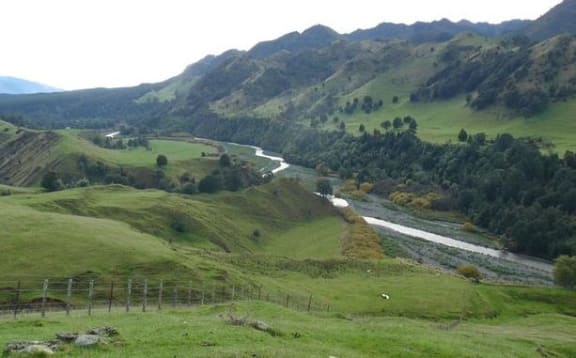A Board of Inquiry into the Ruataniwha Dam in Hawke's Bay has granted resource consents for the $600 million project, but the regional council says it's yet to be determined whether the dam is still viable.
The board has also applied very strict environmental standards around the intensive farming that would result from the water storage project - the biggest irrigation scheme ever to be planned in New Zealand.

The site of the proposed dam. Photo: RNZ
The board sat for 29 days and considered about 28,000 pages of evidence before releasing its draft report on Tuesday. It said one of the most contentious features of the proposal was Hawke's Bay Regional Council's approach to managing phosphorus and nitrogen.
The proposed plan adopted what was described as a 'single nutrient' approach, focusing on the management of phosphorus. Nitrate controls were only intended to avoid toxicity effects on aquatic ecology.
In its findings the board said that, having considered all the information before it, the board rejected this approach in favour of a 'dual nutrient' control which manages phosphorus and nitrogen.
"Rather than basing nitrogen limits on toxicity, the board has taken instream ecological health as the basis of the levels it has set. With the exception of one zone, dissolved inorganic nitrogen levels have been set at 0.8mg/l. The exception is the zone in the headwaters of the catchment where the limit has been set at 0.15mg/l."
Environmental groups had been pushing for nitrogen levels to be set at 0.8mg/l as a level which would ensure the ability of rivers to sustain life.
The regional council only wanted to manage phosphate in the face of fears that intensive agriculture will wreck the Tukituki River.
The Board of Inquiry was not convinced by Hawke's Bay Regional Council's argument that nitrates leeching into waterways from livestock urine don't need to be managed.
The board favoured arguments put forward by the likes of Fish and Game that nitrates need to be managed in order to sustain life in waterways. Environmental groups welcomed the board's decision as good for sustainable agriculture and environmental protection.
Andrew Newman, chief executive of the council-run Hawke's Bay Regional Investment Company, said on Tuesday a key consideration now is whether it has what is known as an operable consent - whether the conditions imposed by the Board of Inquiry still make the plan financially viable.
"We've got to work through a process essentially to see whether we think it's workable or not."
Mr Newman said council experts are analysing the 700-page draft report to determine this, which could take weeks.
Nitrate science
The science around nitrates has proven to be one of the most controversial aspects of the Ruataniwha Dam.
The regional council commissioned a special computer model call TRIM, which showed for the Tukituki River, the amount of nitrates leeching into the aquifers and rivers from intensive farming didn't matter. It said only phosphorous from the likes of town sewerage being pumped into rivers needed to be managed.
But the draft Department of Conservation document on Ruataniwha, leaked to Radio New Zealand, said that approach may not be sufficient to support life in the affected rivers. It said it was a risky and untested approach. A number of independent freshwater scientists have backed up this view.
The stark contrast in scientific opinion led to the board extending its nine-month inquiry by a month, saying there was significant conflicting technical evidence, particularly on evidence about water quality.
Biggest NZ dam
The proposed Ruataniwha dam would be the biggest irrigation dam built in New Zealand history, holding more than 90 million tonnes of water.
Hawke's Bay Regional Council said the proposed dam has the potential to supply secure irrigation to 25,000 hectares of land for irrigated farming, while improving the water quality and summer flows in the Tukituki River.
However critics of the dam process, such as Hawke's Bay regional councillor Rick Barker, said the public had largely been kept in the dark about the risks of such projects.
National made irrigation a plank of its economic growth agenda in the 2008 and 2011 election campaigns, with plans to subsidise massive irrigation dams to intensify agriculture and boost the economy along the east coast of New Zealand.
The aim is to lift the contribution of exports to gross domestic product from 30 percent to 40 percent by 2025.
The Ruataniwha water storage project is the most advanced of 12 proposed irrigation schemes which have won taxpayer money from a $35 million pool to get such projects to an "investor-ready" stage.
The Government has earmarked $400 million from the partial sale of state owned assets to co-fund the irrigation and water storage schemes.
Investment hurdles
Despite having been granted resource consent, the Ruataniwha Dam still has a few major hurdles ahead of it.
The project suffered a blow recently when a proposed institutional investor, Trustpower, pulled out saying the investment of $50 million was too risky and the returns were not high enough.
Ngai Tahu was a piggy-back investor with Trustpower, relying on its expertise in building and investing in dams to guide its investment. It has warned it will also back out unless alternative institutional investors can be found.
Another major hurdle the council faces is convincing farmers on the Ruataniwha Plains to sign up to buy the water. For construction to begin, it must have signed contracts to supply 40 million tonnes of about 90 million tonnes of water available. Non-binding expressions of interest signed by farmers total 47 million tonnes.
A key question remaining is how many of those expressions of interest can be converted to signed contracts for water by the deadline at the end of June.

